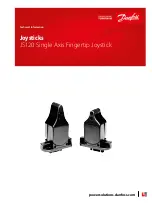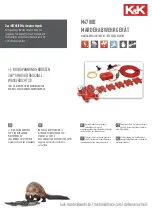
IC\.912 LX Pt100 °R
7/8
DIAGNOSTICS
The alarm condition is always signalled by
the buzzer (if present) and by the led of
the alarm icon
The alarm signal produced by:
• a regulator probe that measures a value
outside probe’s range
• a faulty regulator probe
is shown as E1 on the instrument display
PLEASE NOTE:
In case of wrong connec-
tion of the 3rd wire (Pt100 sensor) in
“AL” folder it will appear the label “Pt3”.
For few seconds the display will shows a
uncorrect temperature.
When the sensor detects an error condi-
tion:
• the code E1 is displayed
• the regulator is activated as indicated by
the "On1" and "OF1" parameters if pro-
grammed for the duty cycle or:
MAXIMUM AND MINIMUM TEMPERA-
TURE ALARM
In case of alarm condition, if alarm exclu-
sion times are not in progress (see, alarm
exclusion parameters), the fixed alarm
icon is turned on and the relay config-
ured as an alarm is activated. This kind of
alarm does not affect the regulation in
progress. Alarms are considered as
absolute (Abs, default) values or as values
related to the Setpoint (rEL, the distance
from the Setpoint itself) and based on the
Att parameter. In this case (Att=rEL), the
HA1 parameter must be set to positive
values and the LA1 parameter to negative
values.
This alarm condition can be viewed in the
folder “AL” with the labels “AH1-AL1”.
EXTERNAL ALARM
The device includes the possibility to con-
trol an external alarm, from a digital input.
If the digital input is active, the alarm con-
trol is activated, if programmed, and stays
until the next time the digital input is
deactivated. The alarm is signaled by turn-
ing on the fixed alarm icon, by activating
the relay configured as alarm, and by
deactivating the other regulators (if speci-
fied by the “H11=9” parameter).
This alarm condition can be viewed in the
“AL” folder with the label “EA”. The relay
can be silenced; even if alarm icon starts
blinking, controls stay locked until the
next time the digital input is deactivated.
DIAGNOSTICS
DISPLAY
E1
FAULT
Faulty probe 1 (thermostat control)
Table of faulty probes
DISPLAY
AH1**
AL1**
EA
Opd
Press any button to silence the alarm. The LED will
start to blink.
ALARM
High temperature alarm (referring to
probe Pb1/Pb2 based on par. H04)
Low temperature alarm (referring to
probe Pb1/Pb2 based on par. H04)
External alarm
Door Open Alarm
Alarm table
Minimum temperature alarm
Maximum temperature alarm
LAL
AFd
HAL
AFd
1
set+ LAL
AFd
Off
set+HAL
AFd
set
2
Temperature lower than or equal to LA1(2) (LA1(2) with sign)
Temperature lower than or equal to set point +LA1(2) positive only)
Temperature greater than or equal to set point +HA1(2) (HA1(2) positive only)
Temperature greater than or equal to HA1(2) (HA1(2) with sign)
Maximum temperature alarm
back swing
Minimum temperature alarm
back swing
Temperature greater than or equal to LA1(2)+AFd
Temperature greater than or equal to set point + LA1(2) + AFd
set point -|LA1(2)|+AFd
Temperature lower than or equal to set point+HAL-AFd
Temperature lower than or equal to HA1(2)-AFd
Temperature expressed as an absolute value (par “Att0)
Abs(olute)
Temperature expressed in relation to set point
(par “Att”=0) reL(ative)
if Att=reL(ative) LA
1(2)
must be negative: therefore
set point+LAL<set point because set point+(-|LA
1(2)
|)=set-|LA
1(2)
|
ALARM DIAGRAM HIGH AND LOW TEMPERATURE
OF1
Off
On
OUT
On1
On1
An error condition in probe 1
(regulation) leads to:
• E1 code appears on display
• activation of controller as
indicated by the “On1” and
“OF1” parameters if pro-
grammed for the duty cycle
Ont
0
0
>0
>0
OFt
0
>0
0
>0
Compressor output
OFF
OFF
ON
dc
DUTY CYCLE DIAGRAM
On1 OF1 parameters programmed for
Duty Cycle


























